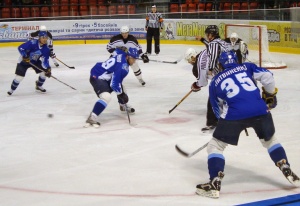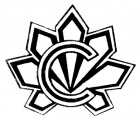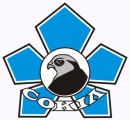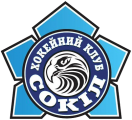Sokil Kiev
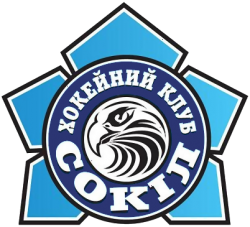 | |
| Full name |
Hockey Club Sokil Kiev
|
|---|---|
| Nickname(s) | "White-Blues", "Falcons" |
| Founded | 1963 |
| Based In | Brovary |
| Arena |
Kiev Palace of Sports (Capacity: 7,200) |
| League | Ukrainian Championship |
| Team Colors | |
| Website | HCSokol.com.ua |
main
Hockey Club Sokil Kiev (Template:Lang-uk; Russian: ХК Сокол Ки́ев, HC Sokol Kiev; English: Falcon Hockey Club), commonly known as Sokil Kiev or HC Sokil, is a Ukrainian hockey team based in Kiev, the capital of Ukraine. While their home arena is located in the city, the team also plays out of Brovary, still within the Kiev region. They were a founding club of the Professional Hockey League of Ukraine, and have formerly competed in the national leagues of Belarus, Russia, and the Soviet Union. To date, Sokil remains the oldest and most accomplished team in Ukrainian hockey, winning a total of 12 Ukrainian Hockey Championships since 1992.
The club was founded in 1963 as part of the Dynamo sports society, and adopted its current moniker in 1973. They are the second major-professional ice hockey team to represent the city of Kiev, preceded only by its short lived predecessor, also named Dynamo (founded in 1953). They are the most successful Ukrainian team to have competed in the Soviet Championship, finishing as high as third in the highly competitive circuit (1985) and producing several award winning players. In 1986, Sokil managed to become the first and only Ukrainian-based team to compete in the Spengler Cup ice hockey tournament, where they would finish 2nd. They also became the first Ukrainian team to win an international league championship, doing so in the Eastern European Hockey League consecutively in 1998 and 1999.
After the PHL's demise, Sokil again played in the Ukrainian Championship in 2013-14. The club was inactive for the 2014-15 season.
Franchise history
1963-1973: Dynamo
The team was founded in the summer of 1963 by the Deputy Chairman of Sports of Ukraine, Adrian Miziak, under the name of Dynamo Kiev. 1963 may be the official birth date of the team, but it was a decade earlier that a Dynamo team from Kiev would play in the Soviet Cup, making it as far as the second round of the playoffs. The current incarnation, however, would begin its hockey operations in the second tier of Soviet ice hockey, holding its first game on October 27, 1963 against SKA Kuybyshev. The team's first head coach was Dmitri Boginov. Forward Viktor Martinov would score the first goal in club history two minutes into the match, and the team would go on to win the game at a score of 4:1. Martinov would go on to lead the team in goals that season with 16. Though the team would finish 6th in its inaugural season, they would go on to have the best record in their division the following year; earning a promotion to the top level of competition in the Soviet leagues. To open the 1965-66 season, Kiev would boast the second largest arena in the Soviet Union. However, while competing at the top level, Dynamo struggled. During its five years of competition in the league, which included playoff qualification each year, the team would exhibit sub-par play. Sokil's Soviet Cup playoff run in 1968 would prove to be a highlight in otherwise disappointing campaigns. Their elimination by SKA Leningrad in the quarterfinals would be the furthest the team would finish in the tournament for nearly a decade. In the following season, Sokil would finish the first round of competition in 10th place of 12 teams, resulting in a temporary demotion to the second-tier of competition. This would last the remainder of the season. They would finish 6th in this group of 18, and 12th of 24 in the record books. This poor showing would not prove a motivator for the following year, though the departure of coach Boginov would not help either. He would be replaced by Igor Shichkov, the team would finish dead last in the 1969-70 season, and once again become subject to outright relegation. The final three years under the Dynamo name would show gradual, albeit slow improvements; each season finishing one place higher in the standings.
1973-1996: The Falcons
For the clubs 10th year anniversary in 1973, the club would drop the Dynamo moniker, a move which would have a lasting legacy. The historical white and blue colors of the Dynamo sports society would be kept intact, but the team would adopt the name of the "Falcon", or "Sokil" in Ukrainian. Though Sokil's play would remain inconstant throughout the 70s, the hiring of Anatoli Bogdanov as head coach in 1976 would have an immediate impact on the teams fortunes. By the 1978 season, the team would finish 2nd overall and re-ascend to the top of the Soviet league. In their first season back, great goaltending by Konstantin Gavrilov managed to overcome a poor offense, and ultimately allowed the team squeak into the playoffs, bypassing Avtomobilist Sverdlovsk by a mere point. This foray into Soviet Cup playoffs would prove to be one of the best runs in the teams history, making it as far as the semifinals where they would ultimately fall to the legendary CSKA Moscow team. Unfortunately for the team, the Cup playoffs would not be held again for another 8 years. During this period of emphasis on regular season performance, several stars would begin to emerge from the team's ranks. Between 1981 to 1990, six players would be named to the league's 34 man All Star selections, 5 of whom were multiple time recipients.
Sokil would remain competitive, but the addition of homegrown forward Dmitri Khristich and defenseman Alexander Godynyuk in 1985 and 1986, respectively, would elevate the team to new heights. Their 3rd place finish in 1985 would remain a franchise best, Ramil Yuldashev would claim the league award for most hat-tricks this year with 2, and Nikolai Narimanov would lead the league in goals with 26. The following year in 1986, Sergei Davydov would follow up on Yuldashev's success and win the hat-trick award. Sokil would be invited to the Spengler Cup tournament where they would continue their success as finalists, succumbing only to Team Canada.
Winning the Tampere Cup in 1989 marked a turning point for the franchise, which would be a victim to the Soviet Union's collapse. The coming down of the Iron Curtain would allow the Los Angeles Kings of the National Hockey League to draft rising local talent and Kiev teammate Alexei Zhitnik 81st overall in the 1991 NHL draft. Zhitnik would remain the highest drafted professional Sokil player to this day. Not all talent was affected, however, as Yuldashev would lead the league in goals in 1990 along with points in 1991, and Valeri Shyriaiev would be named the league's top defensemen in both years as well. Following a 15th place finish in 1992, the lowest in team history, the team and coach Bogdanov would part ways. This would also mark a change in the team's official name to accommodate a new sponsor; the club competed under the name Sokil Eskulap (Ukrainian: Сокіл-Ескулап, Russian: Сокол-Эскулап) for only the 1992-93 International Hockey League (IHL) season. Bogdanov's dismissal did little to curtail the franchise's downward spiral, with the team reaching new record lows with head coach Alexander Fedeev at the helm. He would hold the position until 1996, which also marked the team's parting of ways with the newly formed Russian Hockey League.
A positive product of these troubled years is the continued development of local talent. Future Olympian and Stanley Cup champion, Ruslan Fedotenko would leave the team in 1996 to pursue his NHL dreams. Kievans Anton Babchuk and Nikolai Zherdev, products of the Sokil junior development program, would later be recruited by Elektrostal scouts in the Russian Major League. They would later be drafted into the NHL, both in the first round.
1996-2009: Transitions
With the dissolution of the IHL, orphaned teams from the Soviet Bloc found a home in the newly formed Eastern European Hockey League. Benefiting from a lower level of competition than that of the Russian league, and new head coach Oleksandr Seukand, the team would find renewed success. Sokil would finish 1st overall in 4 of the league's 8 seasons, and become league champions in both 1998 and 1999. Sokil players like Valentin Oletskiy (1997, 2000) and Dmitri Markovskiy (1998) would secure scoring titles, Konstantin Kasyanchuk was awarded league forward MVP in 2001, and Vadim Seliverstov was named top goaltender in 2003. From 2004 through to the 2006-07 season, the team would also compete in the Open Championship of Belarus, the EEHL's spiritual successor. Here they would continue their success until hitting a metaphorical wall in 2006-07, allowing more than twice as many goals against than for, and ultimately not qualifying for the playoffs. It would be the first time they would not qualify for a league playoff in over a decade. In spite of government cuts to hockey programs in the city, the team would realign its franchise with Russia, though this time with the more modest Russian Major League. Here, they received relative success. In their first season, Sokil would finish 5th in the division, 8th overall in wins. On top of these improvements, they would carry the 4th most potent offense in the league. The newly revived team was met with continued success in the Russian league, finishing with the best regular season record that year; 4th overall in points percentage. They would qualify for a bye in the first round, handily defeat Ryazan in the secondaries, but would ultimately fall to Yugra Khanty-Mansiysk in a 3-1 lopsided series.
2009-present
Following the 2008-09 season in the Russian league, the club announced they would rejoining the Belarusian Extraliga for the following year. This was a move largely attributed to the financial burdens brought on by the Russian Ice Hockey Federation's (RHF) mandate that foreign teams pay for the travel, accommodations, and meals of visiting teams. The RHF also demanded that foreign teams pay an annual fee of p.1,500,000 (approx €35,000).
Going into the 2009-10 Extraleague season, Sokil elevated team expenditures and signed several Ukrainian players who had been in the Kontinental Hockey League, bolstering the roster with professional names such as Kostiantyn Simchuk, Sergei Varlamov, and Serhiy Klimentiev. They would face further financial difficulties, losing players along the way (including Varlamov), and finish 4th in the Belarusian league's standings, ultimately falling to Yunost Minsk in the semifinals. Sokil would continue their winning streak in the Ukrainian Championship, however, winning their 12th championship. The teams financial issues continued in the 2010-12 season, however, and apart from losing many key players, the team missed the Belarusian league's playoffs and their streak in the Ukrainian Championship was broken, when they lost to HC Donbass in the finals. For the 2012 season, Sokil withdrew from the Belarusian league and joined the newly formed Professional Hockey League of Ukraine.
During its first two years in the PHL, Sokil forfeited its streak of Ukrainian Championships, with rival HC Donbass-2 becoming the new national standard. To make matters worse, the team was mired in financial difficulties, with players alleging that they were not being paid by the team.[1]
In December 2013, players on the team went on strike due to not being paid their salaries, which stemmed from sponsorship issues. The team was forced to forfeit games.[2]
The club was inactive for the 2014-15 season.
Club logos
The team's original colors as Dynamo were, hence the nickname that has held to this day ("white-blues"), white and blue. When the Sokil name was adopted, the team changed their colors to red and blue, the same colors of the Kiev coat of arms of the time. The team would eventually return to its white and blue roots, along with the addition of a darker accent of blue, as well as black. Sokil's primary logo has, since 1973, featured a horse-chestnut leaf, the symbol of the city. This element has remained constant on both the chest piece as well as the shoulder patches throughout the team's history since adopting the "Sokil" name. The adding of a profile image of a falcon was added later on, and the team would return to its white and blue roots. To mark their 45th anniversary, Sokil updated their classic team logo for the 2008-09 season. The re-branding saw a modernization of the team's crest; with a new and more aggressive falcon centerpiece, while retaining the classic, albeit broadened, chestnut leaf backdrop.
Seasons and records
Season by season results
- Main article: List of Sokil Kiev seasons
League history and results
Soviet era
<timeline> ImageSize = width:990 height:60 PlotArea = left:10 right:10 bottom:30 top:10 TimeAxis = orientation:horizontal format:yyyy DateFormat = dd/mm/yyyy Period = from:01/01/1963 till:01/07/1991 ScaleMajor = unit:year increment:1 start:1963 Colors =
id:elite value:rgb(0.4,0.6,1) id:1 value:rgb(0.5,0.8,0.5) id:1b value:rgb(0.6,0.9,0.6) id:2 value:rgb(0.9,0.9,0.3) id:2b value:rgb(0.8,0.8,0.2) id:3 value:rgb(0.9,0.7,0.1) id:4 value:rgb(0.9,0.1,0.1) id:champ value:rgb(0.8,0.8,0.6)
PlotData=
bar:Position width:15 color:white align:center
from:01/07/1963 till:01/07/1964 shift:(0,-4) text:6 from:01/07/1964 till:01/07/1965 shift:(0,-4) text:2 from:01/07/1965 till:01/07/1966 shift:(0,-4) text:9 from:01/07/1966 till:01/07/1967 shift:(0,-4) text:9 from:01/07/1967 till:01/07/1968 shift:(0,-4) text:9 from:01/07/1968 till:01/07/1969 shift:(0,-4) text:12 from:01/07/1969 till:01/07/1970 shift:(0,-4) text:12 from:01/07/1970 till:01/07/1971 shift:(0,-4) text:6 from:01/07/1971 till:01/07/1972 shift:(0,-4) text:5 from:01/07/1972 till:01/07/1973 shift:(0,-4) text:4 from:01/07/1973 till:01/07/1974 shift:(0,-4) text:9 from:01/07/1974 till:01/07/1975 shift:(0,-4) text:3 from:01/07/1975 till:01/07/1976 shift:(0,-4) text:6 from:01/07/1976 till:01/07/1977 shift:(0,-4) text:7 from:01/07/1977 till:01/07/1978 shift:(0,-4) text:2 from:01/07/1978 till:01/07/1979 shift:(0,-4) text:9 from:01/07/1979 till:01/07/1980 shift:(0,-4) text:6 from:01/07/1980 till:01/07/1981 shift:(0,-4) text:6 from:01/07/1981 till:01/07/1982 shift:(0,-4) text:5 from:01/07/1982 till:01/07/1983 shift:(0,-4) text:4 from:01/07/1983 till:01/07/1984 shift:(0,-4) text:5 from:01/07/1984 till:01/07/1985 shift:(0,-4) text:3 from:01/07/1985 till:01/07/1986 shift:(0,-4) text:4 from:01/07/1986 till:01/07/1987 shift:(0,-4) text:9 from:01/07/1987 till:01/07/1988 shift:(0,-4) text:6 from:01/07/1988 till:01/07/1989 shift:(0,-4) text:5 from:01/07/1989 till:01/07/1990 shift:(0,-4) text:5 from:01/07/1990 till:01/07/1991 shift:(0,-4) text:8
from:01/01/1963 till:01/07/1965 color:2 shift:(0,13) text: "USSR-2" from:01/01/1965 till:01/07/1970 color:1 shift:(0,13) text: "USSR" from:01/07/1970 till:01/07/1978 color:2 shift:(0,13) text: "USSR-2" from:01/07/1978 till:01/07/1991 color:1 shift:(0,13) text: "USSR"
</timeline>
Modern era
<timeline> ImageSize = width:627 height:60 PlotArea = left:10 right:10 bottom:30 top:10 TimeAxis = orientation:horizontal format:yyyy DateFormat = dd/mm/yyyy Period = from:01/01/1991 till:01/07/2013 ScaleMajor = unit:year increment:1 start:1992 Colors =
id:elite value:rgb(0.4,0.6,1) id:1 value:rgb(0.5,0.8,0.5) id:1b value:rgb(0.6,0.9,0.6) id:2 value:rgb(0.9,0.9,0.3) id:2b value:rgb(1,1,0.4) id:3 value:rgb(0.9,0.7,0.1) id:4 value:rgb(0.9,0.1,0.1) id:champ value:rgb(0.8,0.8,0.6)
PlotData=
bar:Position width:15 color:white align:center
from:01/07/1991 till:01/07/1992 shift:(0,-4) text:15 from:01/07/1992 till:01/07/1993 shift:(0,-4) text:14 from:01/07/1993 till:01/07/1994 shift:(0,-4) text:17 from:01/07/1994 till:01/07/1995 shift:(0,-4) text:24 from:01/07/1995 till:01/07/1996 shift:(0,-4) text:21 from:01/07/1996 till:01/07/1997 shift:(0,-4) text:1 from:01/07/1997 till:01/07/1998 shift:(0,-4) text:1 from:01/07/1998 till:01/07/1999 shift:(0,-4) text:1 from:01/07/1999 till:01/07/2000 shift:(0,-4) text:2 from:01/07/2000 till:01/07/2001 shift:(0,-4) text:3 from:01/07/2001 till:01/07/2002 shift:(0,-4) text:8 from:01/07/2002 till:01/07/2003 shift:(0,-4) text:3 from:01/07/2003 till:01/07/2004 shift:(0,-4) text:4 from:01/07/2004 till:01/07/2005 shift:(0,-4) text:4 from:01/07/2005 till:01/07/2006 shift:(0,-4) text:6 from:01/07/2006 till:01/07/2007 shift:(0,-4) text:10 from:01/07/2007 till:01/07/2008 shift:(0,-4) text:7 from:01/07/2008 till:01/07/2009 shift:(0,-4) text:4 from:01/07/2009 till:01/07/2010 shift:(0,-4) text:4 from:01/07/2010 till:01/07/2011 shift:(0,-4) text:7 from:01/07/2011 till:01/07/2012 shift:(0,-4) text:1 from:01/07/2012 till:01/07/2013 shift:(0,-4) text:5
from:01/01/1991 till:01/07/1992 color:1 shift:(0,13) text: "CIS" from:01/07/1992 till:01/07/1996 color:1b shift:(0,13) text: "IHL" from:01/07/1996 till:01/07/2004 color:2 shift:(0,13) text: "Eastern European Hockey League" from:01/07/2004 till:01/07/2007 color:2b shift:(0,13) text: "BLR" from:01/07/2007 till:01/07/2009 color:2 shift:(0,13) text: "RUS-2"
from:01/07/2009 till:01/07/2011 color:2b shift:(0,13) text: "BLR" from:01/07/2011 till:01/07/2013 color:3 shift:(0,13) text: "PHL"
from:01/07/1997 till:01/07/1999 color:champ shift:(0,13) text:
</timeline>
Team awards
League Champions
- Eastern European Hockey League Championship: (2) 1998, 1999
- Ukrainian Hockey Championship: (12) 1993, 1995, 1997, 1998, 1999, 2003, 2004, 2005, 2006, 2008, 2009, 2010
Tournaments
- Ukrainian Cup: (1) 2007
- Danube Cup: (2) 1968, 1970
- Tampere Cup: (1) 1989
Runner Up
![]() Soviet Championship League (1): 1985
Soviet Championship League (1): 1985
References
External links
- Team profile on eurohockey.com
| This page uses Creative Commons Licensed content from Wikipedia (view authors). |

